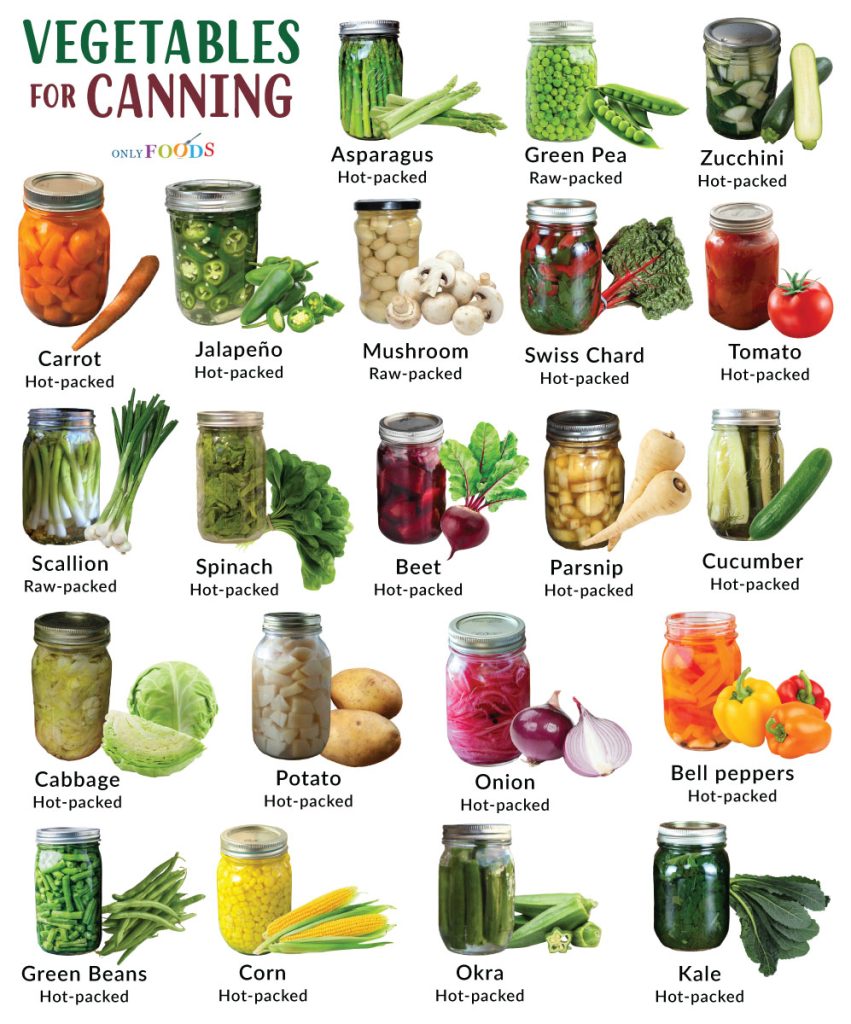Vegetables Good for Canning
Whether you have your favorite vegetables growing in your backyard or have been making regular trips to the farmer’s market to find all the in-season harvests, it is natural to end up with more fresh vegetables than you could possibly use up before they go bad. In such times, canning all the extra vegetables is the most effective way to preserve them.
Canning simply means putting fresh fruits, vegetables, meats, and other similar perishable items into large glass containers that lengthen their shelf life. The USDA approves two canning methods for home canning – pressure canners and water baths (boiling-water canners).
It is essential to understand the methods and properly follow the steps because canned fruits and vegetables can easily get contaminated by bacteria and harmful microbes, with Botulism being the biggest risk.
Canning Vegetables: Pressure Canning or Water Bath
A pressure canner is similar to a pressure cooker but large enough to fit 4 or more quart jars. Though each model has different features, a pressure canner can often be used for water baths as well.
Out of the two canning methods, pressure canning is for low-acid foods, while high-acid foods need the water bath technique. Since vegetables are usually low-acid, they need to be pressure-canned.
All the vegetables in the list below are meant to be pressure canned, except cucumbers, as they are almost always pickled before canning.
Tomatoes are another point to mention because though they may seem acidic, their acid levels are just at the borderline where you can use either pressure or water canning. However, most reliable resources recommend pressure canning unless you store them as a sauce.
Pickled vegetables are acidic enough to be suitable for water bath canning.
Best Vegetables for Canning With How to Do it
When you can just cut, clean, and pack a vegetable directly into the jars, it is raw-packing for canning. Similarly, hot-packing is when vegetables must be cleaned and blanched before canning.
The jar size is usually a quart or a pint. Whether using a hot- or cold-pack, remember to leave about 1-inch head-space for all vegetables.
| Name of Vegetable | How to Can | Preparing for Canning | Raw-packed or Hot-packed |
|---|---|---|---|
| Tomato | Whole or diced | Remove skins and cores, blanch and then peel | Hot-packed |
| Green Beans | Whole or cut | Trim ends | Hot-packed |
| Carrot | Sliced or diced | Peel and cut into desired shapes | Hot-packed |
| Bell peppers | Diced or sliced | Remove seeds and membranes | Hot-packed |
| Jalapeño | Sliced | Remove seeds | Hot-packed |
| Cucumber | Pickles | Trim ends, peel or leave skin on, slice or leave whole | Hot-packed |
| Beet | Sliced or diced | Peel and cut into desired shapes | Hot-packed |
| Corn | Whole kernel or cream-style | Remove kernels from cob | Hot-packed |
| Asparagus | Whole spears or cut | Trim ends | Hot-packed |
| Green Pea | Whole or crushed | Shell peas | Raw-packed |
| Potato | Cubed or whole | Peel and cut into desired shapes | Hot-packed |
| Onion | Sliced or diced | Peel and chop | Hot-packed |
| Mushroom | Whole or sliced | Clean and slice | Raw-packed |
| Okra | Whole or sliced | Trim ends | Hot-packed |
| Zucchini | Sliced or diced | Peel and cut into desired shapes | Hot-packed |
| Cabbage | Shredded | Shred | Hot-packed |
| Spinach | Chopped | Wash and chop | Hot-packed |
| Kale | Chopped | Wash and chop | Hot-packed |
| Swiss Chard | Chopped | Wash and chop | Hot-packed |
| Scallion (Green Onion) | Sliced | Trim ends | Raw-packed |
| Parsnip | Sliced or diced | Peel and cut into desired shapes | Hot-packed |
FAQ
The shelf life of canned vegetables depends on how well they are canned and stored. USDA states you should not store home-canned foods for over a year. That too only if the cans are in an ideal condition: there are no dents, leakage, or rust, and they are kept in a cool and dry place.
One thing to remember is that you should never taste canned vegetables to check if they are okay. Also, throw away everything without a second thought if the jar is damaged.
The only USDA-approved device for the purpose is a pressure canner. Still, people often use their plug-in cookers and instant pots for canning at home. If you are doing it, make sure to follow all the instructions and safety measures.
It is possible to can frozen vegetables as long as you thaw them well. However, since freezing vegetables often make them lose their texture and become mushy, canning them may not be desirable because the result may not be palatable.

